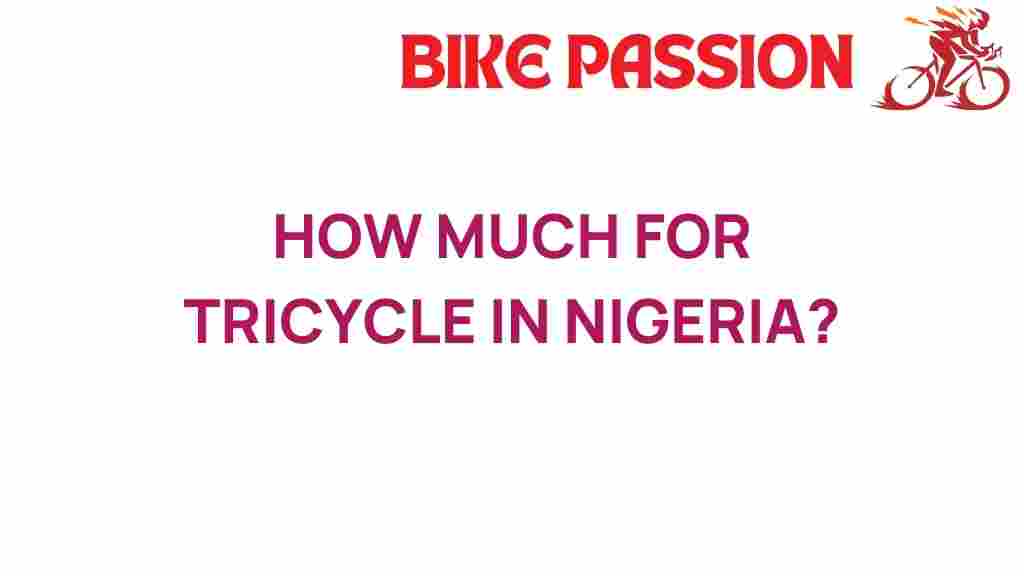Unraveling the Cost of Tricycles in Nigeria: What You Need to Know
In recent years, tricycles have emerged as a popular mode of transportation in Nigeria, offering an affordable and efficient mobility solution for many. As urbanization increases and traffic congestion becomes a pressing issue, understanding the tricycle cost in Nigeria is essential for potential buyers and investors. This article delves into the various factors influencing tricycle prices, market trends, and offers valuable insights into making an informed purchasing decision.
The Rise of Tricycles in Nigeria
Tricycles, often referred to as “Keke NAPEP” in Nigeria, have become a common sight on the roads, especially in densely populated urban areas. They serve as a reliable means of transportation for both passengers and goods, filling gaps left by other forms of public transport. The increasing demand for tricycles has significantly influenced their vehicle prices in the Nigerian market.
Factors Influencing Tricycle Cost in Nigeria
Several key factors determine the tricycle cost in Nigeria:
- Brand and Model: Different manufacturers produce tricycles with varying features, which can affect the price. Popular brands often command higher prices due to their reliability and reputation.
- Engine Capacity: Tricycles with larger engines typically cost more. This is due to increased power, which allows them to carry heavier loads and navigate through traffic more efficiently.
- Condition: The condition of the tricycle, whether new or used, significantly impacts its cost. New tricycles come with warranties and modern features, while used ones may offer a more budget-friendly option.
- Market Trends: Fluctuations in demand and supply, influenced by economic factors, can lead to variations in prices. Keeping an eye on market trends can help you anticipate price changes.
- Location: Prices can vary by region, with urban areas often seeing higher prices due to demand compared to rural areas.
Current Market Trends in Tricycle Prices
The tricycle market in Nigeria has seen some interesting trends in recent years:
- Increased Demand: With the rise in population and urban migration, the demand for efficient transportation options has increased, driving up prices.
- Adoption of Technology: Many new tricycle models come equipped with modern technology, including GPS and fuel-efficient engines, which can increase their price but also offer better long-term value.
- Government Policies: Policies aimed at promoting local manufacturing can affect the prices of imported versus locally assembled tricycles.
- Economic Factors: Inflation and changes in currency exchange rates can lead to fluctuations in the cost of tricycles, especially those that are imported.
Economic Factors Affecting Tricycle Costs
Understanding the economic landscape is crucial when considering the tricycle cost in Nigeria. Here are some factors to consider:
- Inflation: Nigeria has experienced periods of high inflation, which can increase the cost of materials and manufacturing, thus raising tricycle prices.
- Fuel Prices: As a fuel-dependent mode of transport, fluctuations in fuel prices can influence operational costs for tricycle owners, indirectly affecting the purchasing price.
- Import Tariffs: Any changes in import tariffs on vehicle components can lead to variations in the prices of imported tricycles.
Purchasing Guide for Tricycles in Nigeria
When considering purchasing a tricycle, here’s a step-by-step guide to help you navigate the process:
- Research: Start by researching different brands and models of tricycles available in the Nigerian market. Look at reviews and user experiences to gauge reliability.
- Set a Budget: Determine how much you are willing to spend. This will help narrow down your options and prevent overspending.
- Visit Dealerships: Visit local dealerships to see the tricycles in person. Test drive different models to find one that suits your needs.
- Check for Financing Options: If you are unable to pay the full price upfront, explore financing options offered by dealerships or banks.
- Consider Insurance: Protect your investment by considering insurance options that cover accidents, theft, and damages.
- Review Documentation: Ensure that all documentation, including registration and ownership papers, is in order before finalizing the purchase.
Common Troubleshooting Tips for Tricycle Owners
Owning a tricycle comes with its own set of challenges. Here are some common troubleshooting tips:
- Engine Issues: If the engine fails to start, check the battery connections and ensure there’s sufficient fuel.
- Overheating: If your tricycle overheats, check the coolant levels and ensure the radiator is functioning properly.
- Brake Problems: If the brakes are not responsive, it may be time to replace the brake pads or check for fluid leaks.
- Flat Tires: Carry a spare tire and a basic toolkit to address flat tires promptly.
Conclusion
Understanding the tricycle cost in Nigeria is essential for anyone considering this mode of transportation. With various factors influencing prices, from market trends to economic conditions, it’s crucial to conduct thorough research before making a purchase. By following the purchasing guide and being aware of common issues, you can make an informed decision that suits your mobility needs and budget.
For more information on vehicle prices and to stay updated with the latest trends in transportation solutions, check out this resource.
If you’re looking for local dealerships or want to connect with other tricycle owners, consider joining community forums or visiting transportation websites for valuable insights.
This article is in the category Gear and created by BikePassion Team
